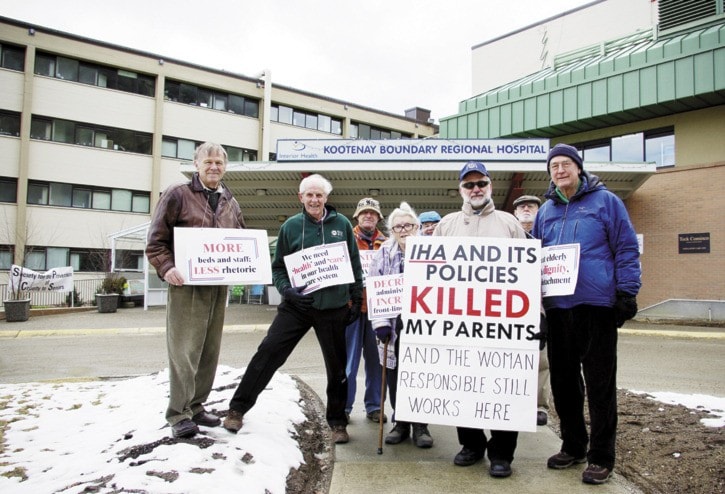A group of senior advocates stood outside the Trail hospital to mourn the loss of services Monday, a ritual that has occurred since 2006.
About 10 residents – some belonging to Trail’s Society for the Prevention of Cruelty to Seniors (SPCS) and others with the Castlegar Health Watch – gathered at Kootenay Boundary Regional Hospital with signs protesting insufficient senior care.
The annual vigil started when local Jim Albo said Interior Health’s policy left his mother to die alone six years ago.
“When your parents get old and you get to the situation where you’ve got to look after an elderly parent, putting them into a facility is really the last thing you’d like to do but sometimes there’s no other resort,” said Albo. “(The health authority) should be helping you with that, not hindering and blocking you every step of the way.”
His mother Fanny Albo was transferred in February 2006 at 91 years old from the Trail hospital to a facility in Grand Forks, where she died two days later, apart from her husband and family. A broken-hearted Alfie Albo, who was also a patient at KBRH when his wife of 69 years was moved, died a week later.
IH has since revised its policy by ensuring family members approve patient transfers. It then provides temporary placements for seniors without removing them from a preferred residential-care placement list.
“Interior Health has made it our priority to have family members stay together or in the same complex, depending on the level of care each requires – Interior Health’s introduction of assisted living units in the same facilities as residential care beds allows for couples with different individual needs to live in the same facility,” explained Cindy Kozak-Campbell, Interior Health residential care health services administrator.
“IH recognizes this plays a part in maintaining the couple’s health and well being. Each case is looked at individually, with the care of each member of a couple taken into account.”
But Albo said the same story continues to play out, pointing to an elderly Penticton couple – married for more than 60 years – who spoke out last month after being placed in separate medical facilities by Interior Health.
Ken McKay and his wife Dusty were split up when she needed 24-hour medical care. While Interior Health provided them with living options that included keeping them together, that option a wait, which wasn’t a plausible choice due to Dusty’s condition.
Trail’s senior group along with other advocacy groups in the West Kootenay that make up Connected Communities have recently released a report that studies the changes to health care services in the region from 2002 to 2010.
A number of trends in the local delivery of health care services have been identified, including the centralization and reduction in health care services, the addition of costly expansions to facilities while basic health services are cut and burgeoning administrative costs.
“I see the creeping privatization of health care and I feel that especially elderly people are the most vulnerable, they suffer the most,” said SPCS member Peter VanIersel. “When we look at the proportion of cost –administration to services delivered – is all out of whack.”
From an IH-wide perspective, total administration and support services costs – including spending for facility maintenance and operations, human resources, health records, patient registration, admission and discharge, and facility security – represent less than 11 per cent of the total $1.7 billion budget, according to IH spokesperson Karl Hardt.
Advocate Ron Cameron recalls a time when accountability was at the local level, when a community-council makeup was in place in the mid-80s that functioned well. This was before the government changed hand and the current “administrative-top heavy” structure was introduced.
“It was about 2009 when we became more and more aware that services were being lost,” he said. “It started with residential care, then it was acute care and then it was other ad-junk services so we decided we need to pull it all together in the form of a report.”
Cameron remains hopeful that their report along with recent recommendations made by B.C. Ombudsperson Kim Carter – which highlighted the need to improve home and community care, home support and residential care services – will create change.
For Albo – who continues to relive his parents’ story on the anniversary of his mother’s death – giving up on his message is not an option.
“Unless the government will get behind these recommendations and force these health authorities to enact them, they’re not even going to be worth the paper they’re written on,” he said. “Probably the worst word we could have ever picked for them is authority because they’ve taken that authority to mean that they’re God and they do whatever they bloody well like.”
